Home teams win 208% more often with red card (Study of 19,985 games)
To understand the impact that red cards have on American football matches we have collected data from 19,985 games in Europe’s top 5 leagues over the last 11 years.
The data below includes games from the German Bundesliga, French Ligue 1, Spanish La Liga, Italian Serie A, and English Premier League between seasons 2009/10 and 2019/20.
Key findings:
- Home teams 208% more likely to win a game with a red card than an away team
- Away teams 41.6% more likely to get a red card in a game than the home team
- 62.4% more likely to win if you get a red card in the last 15 minutes of a game than first 15 minutes
- 55.21%: More than half of all red card games are lost by the team with 10 men
- 40.72% of games saw the team concede a goal after receiving a red card
- Teams receiving a red card in the first 15 minutes of a game lose 64.16% of the time
- 21.41% decrease in red cards over 10 years
Home teams 208% more likely to win a game with a red card than an away team
We analysed the 3,310 games from the last 11 years that contained a single red card.
In these games, the home team received the red card in 1,378 games and the away team received the red card in 1,932 games.
Out of the 1,378 games, the home team managed to win an unimpressive 585 games while a man down.
However, out of the 1,932 games where the away team received the red card, the away team only won 266 games.
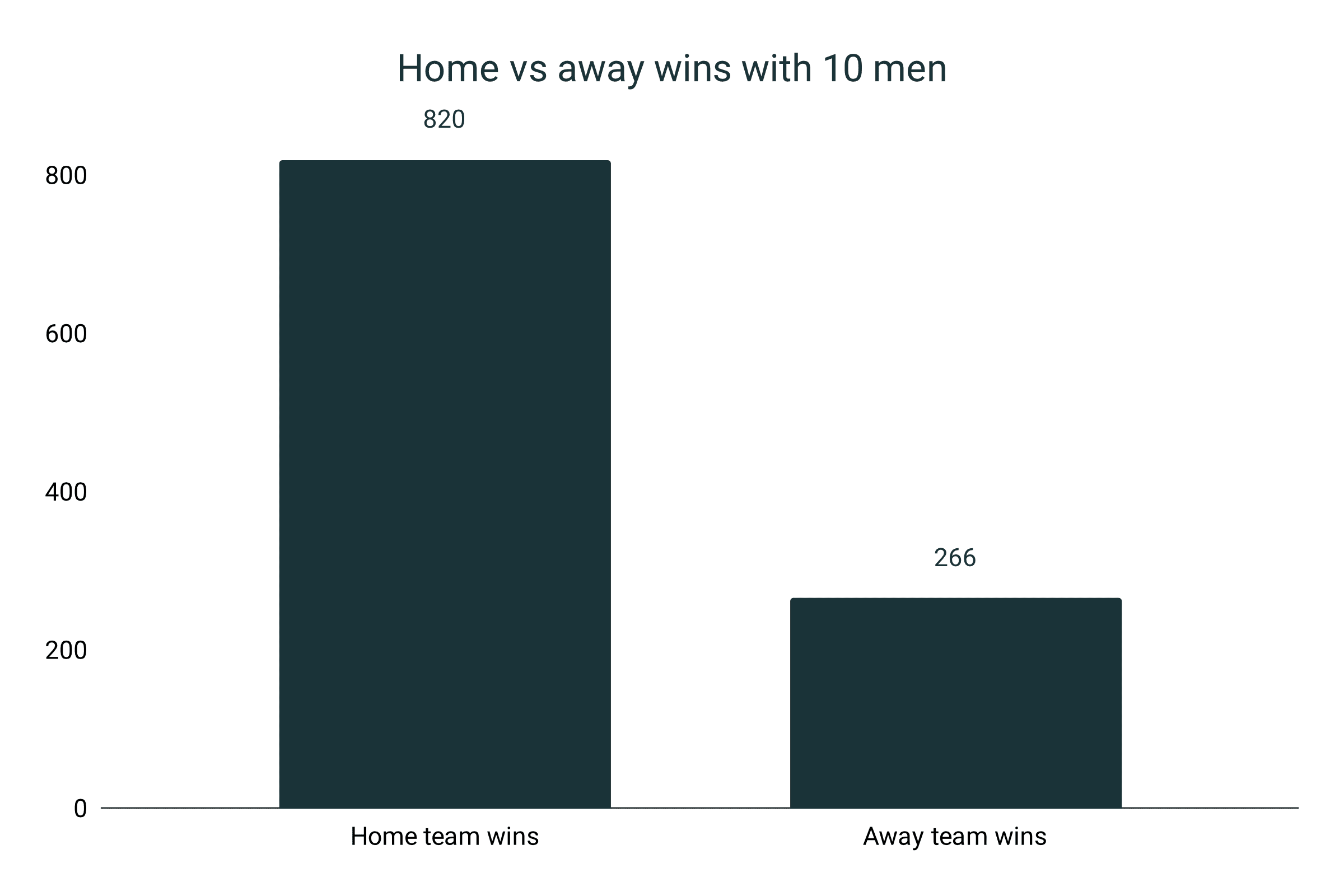
Given there were more red cards for the away team than the home team, after we adjusted the number of home wins to reflect how it would be if all things were equal (i.e. how many wins would home teams have got in 1,932 games) it comes out as 820.
This shows us that home teams are 208% more likely to win after receiving a red card than an away team is.
1 in 5 games contain at least 1 red card
Over the course of the 19,985 games across the top 5 leagues, players received 4,574 red cards.
This works out as a red card every 393.13 minutes or, essentially, a red card every 4.5 games.
Number of games by number of red card given
| Number of red cards | Count of games | % of total games |
| 0 | 16,081 | 80.47% |
| 1 | 3,310 | 16.56% |
| 2 | 527 | 2.64% |
| 3 | 60 | 0.30% |
| 4+ | 7 | 0.04% |
| Total | 19,985 | 100% |
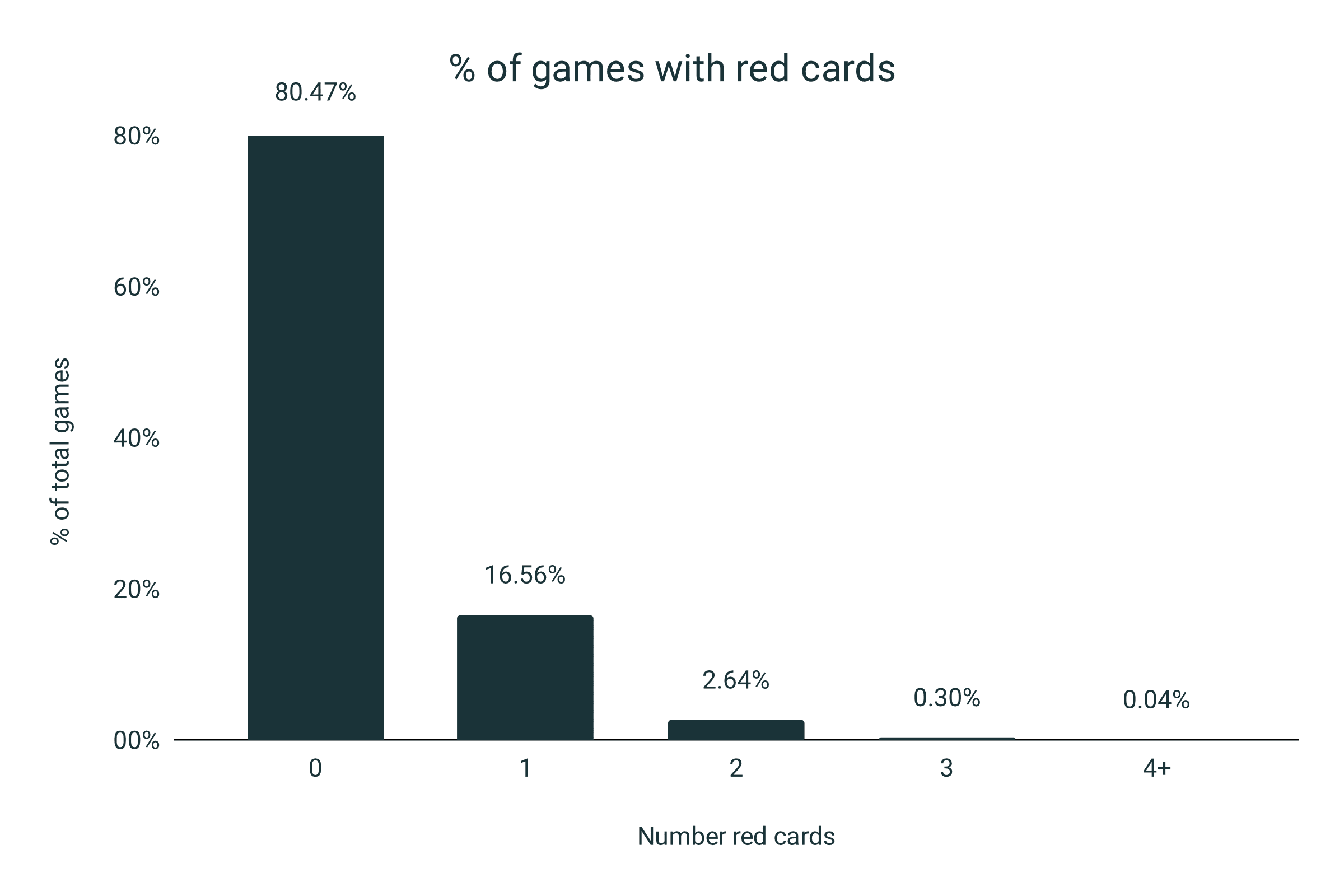
Over the course of the 19,985 games, 3,904 games contained at least one red card. That works out at 19.53% -- nearly 1 in 5 games contain at least 1 red card.
Multiple red cards in a game
In this section, we are only looking at the 3,904 games that contained at least one red card:
- In 84.78% of these games, only 1 red card was shown
- 2 red cards were shown in 13.50% of red card games
- 3 or more red cards were shown in just 1.72% of red card games
21.41% decrease in red cards over 10 years

Over the previous 10 years, there has been a 21.41% reduction in the number of red cards from 467 in 2009/10 to 361 in 2020.
Interestingly, the sharpest decline happened from season 15/16 to season 16/17. Red cards decreased by 16.34% from 453 to 379 after the implementation of the “double jeopardy” rule where players no longer receive a red card for a foul in the box that accidentally denies a goalscoring opportunity while making a legitimate play for the ball.
League by League
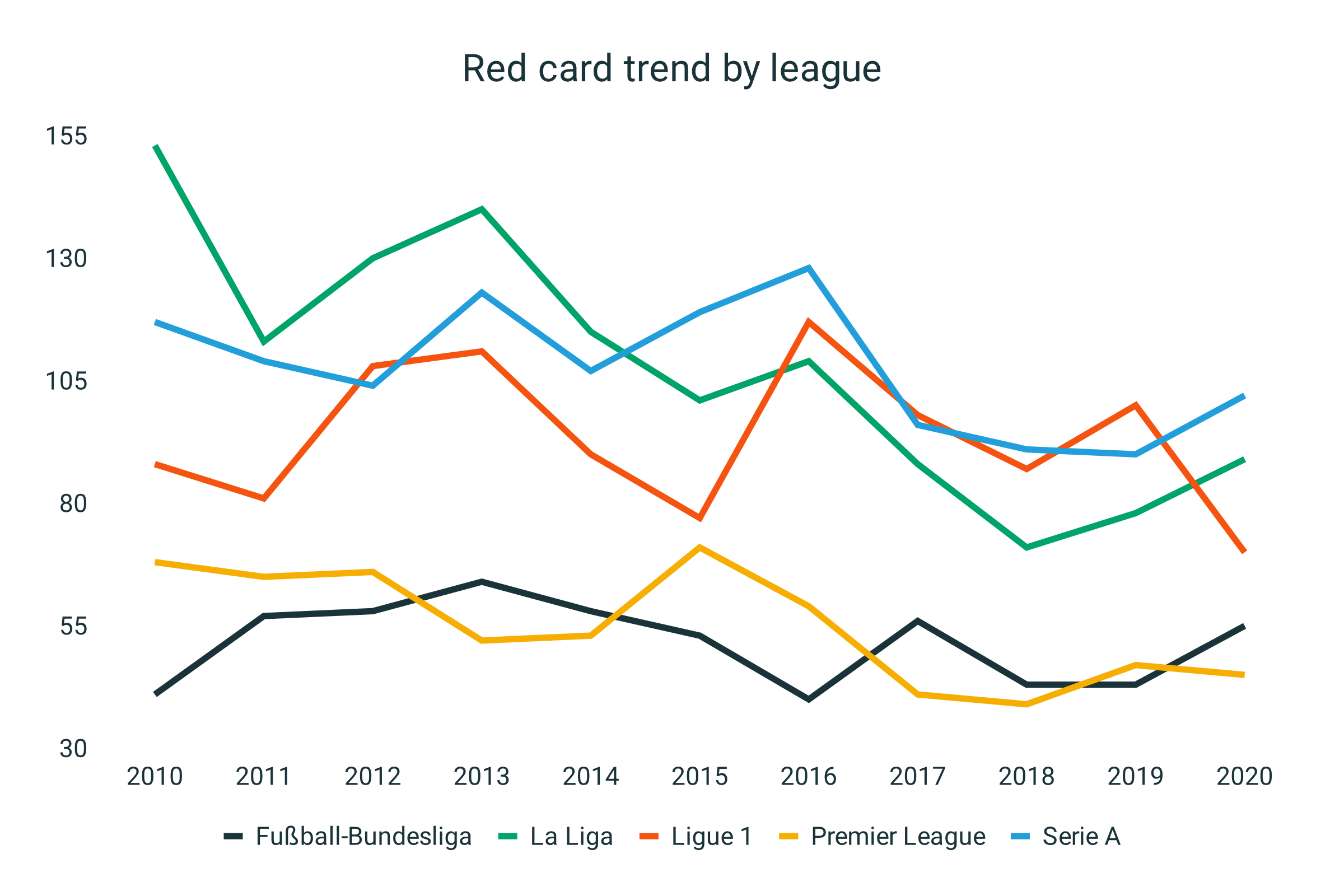
Interestingly, the German Bundesliga and English Premier League have consistently seen the fewest number of red cards over the past 10 years.
Considering these two leagues, especially the Premier League, are often perceived as the most physical or rugged of the top-5 leagues, this came as a surprise.
Ligue 1 was the league with the most red cards in 18/19. In the midst of the pandemic, Ligue 1 was cut short after 28 matchdays in 19/20. Despite all other leagues finishing their seasons, Ligue 1 still had more red cards than the Premier League and Bundesliga.
Interestingly, the Bundesliga is the only league to have had more red cards in season 2019/20 than they did in season 2009/10.
Nothing makes sense with VAR
As with everything VAR, nothing makes much sense.
The double jeopardy rule had a clear impact in reducing the number of red cards per season. To get a fair understanding of the number of red cards prior to VAR, we analysed the average number of red cards per season after double jeopardy was introduced but prior to the introduction of VAR.
This was then compared to the average number of red cards per season after VAR was introduced. We believe this is the fairest way to truly understand what impact VAR has had on the number of red cards being shown across Europe’s top 5 leagues.
When looking at this data, it tells a confusing story:
In Serie A, nothing much changed with the difference well within the expected fluctuation we see from season to season.
Across the other 4 leagues, there was a split. In La Liga and the Premier League, red cards increased by 5.03% and 6.30% respectively.
In Ligue 1 and the Bundesliga, red cards decreased by 8.11% and 16.07%.
Average red cards per season before and after the introduction of VAR
| Competition | Avg. Prior to VAR** | Avg. after VAR | % Change |
| Serie A | 96.00 | 94.33 | -1.74 |
| La Liga | 79.50 | 83.50 | +5.03% |
| Bundesliga | 56.00 | 47.00 | -16.07% |
| Premier League | 42.33 | 45.00 | +6.30% |
| Ligue 1 | 92.50 | 85.00 | -8.11% |
| Avg. All Leagues | 69.22 | 73.27 | +5.85% |
*The first season of VAR for each league was: Serie A - 17/18, La Liga - 18/19, Bundesliga - 17/18, Premier League - 19/20, Ligue 1 - 18/19.
**Avg. prior to var is calculated based on red card totals per league after the implementation of double jeopardy and prior to the implementation of VAR in order to reflect the most complete and accurate data.
Away teams 41.6% more likely to get a red card
In total, there were 3,904 games over the last 11 years in Europe’s top 5 leagues where at least one red card was shown.
Games including at least 1 red card
| Number of red cards | Games with red card home team only | Games with red card away team only | Games with red card both teams |
| 1 | 1,378 | 1,931 | 0 |
| 2 | 80 | 132 | 316 |
| 3 | 1 | 3 | 56 |
| 4+ | 0 | 0 | 7 |
| Total | 1,459 | 2,066 | 379 |
When looking at games where only one team received a red card, the home team received at least one red card in 1,459 games. The away team received at least one red card in 2,066 games.
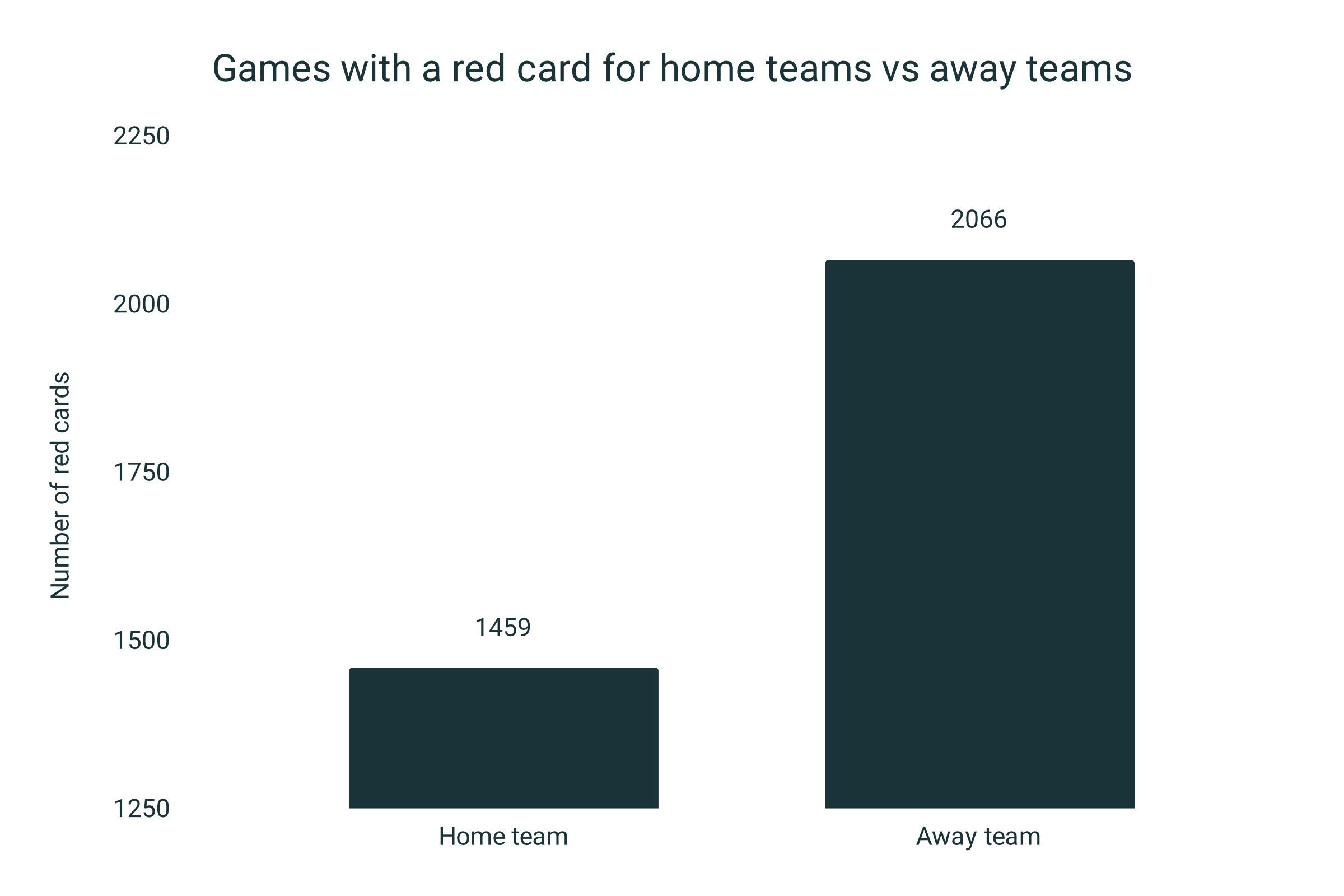
Staggeringly, that translates to the away team receiving a red card in 41.6% more games than the home team does.
Games including red cards for home team vs away team
| Number of red cards | Games with red card home team only | Games with red card away team only |
| 1 | 1,378 | 1,931 |
| 2 | 396 | 448 |
| 3 | 57 | 59 |
| 4+ | 7 | 7 |
| Total | 1,838 | 2,445 |
However, when you also include the games where both teams received at least one red card, this comes down to, a still significant, 33.03%.
Overall it is clear that away teams are receiving more red cards than home teams. Come to the end of this season, when there is enough data to make a reasonable comparison, it will be interesting to see if the lack of fans has narrowed this gap.
Red card frequency per 15 minutes
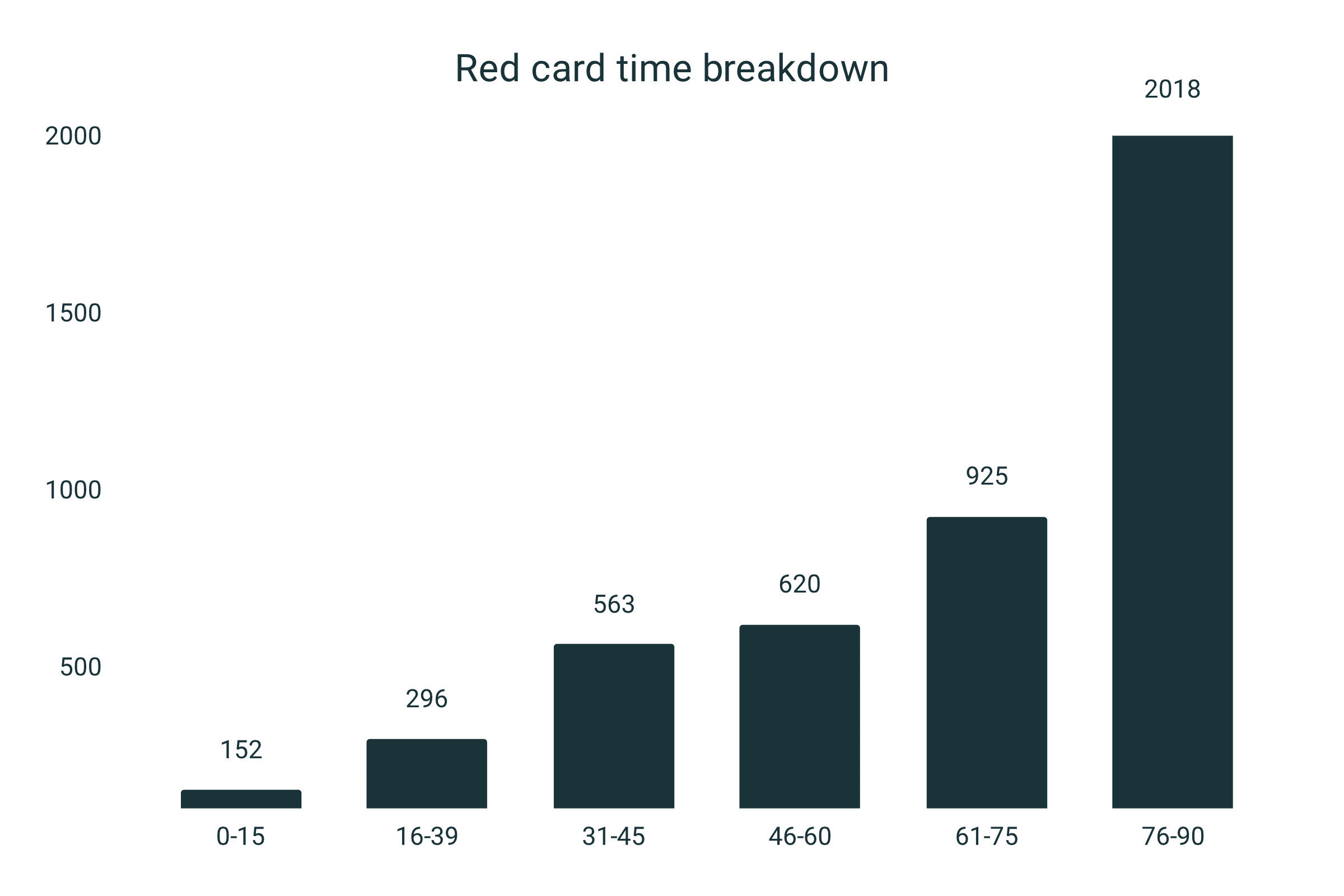
As expected, the number of red cards ramps up throughout the game with the accumulation of yellow cards which sees 3 of every 4 red cards being shown in the second half of games.
Even though it is logical to see more red cards in the second half, it is surprising to see such skewed distribution. This is again borne out with more than a third (37%) of red cards coming in the final 15 minutes.
Again, this is logical with the accumulation of yellow cards combined with teams chasing games and leaving spaces at the back, leading to rash and desperate tackles when teams are caught on the break.
With early red cards more likely to be a straight red than two yellow cards, it’s interesting to see that only 12% of red cards come in the first 30 minutes of games. That’s fewer than 1 of every 8 red cards.
How red card time impacts win percentage
There’s a clear correlation between when a team receives a red card and whether or not they win the game. This becomes clear when you look at win percentages for teams with 10 men broken down by 15 minute intervals.
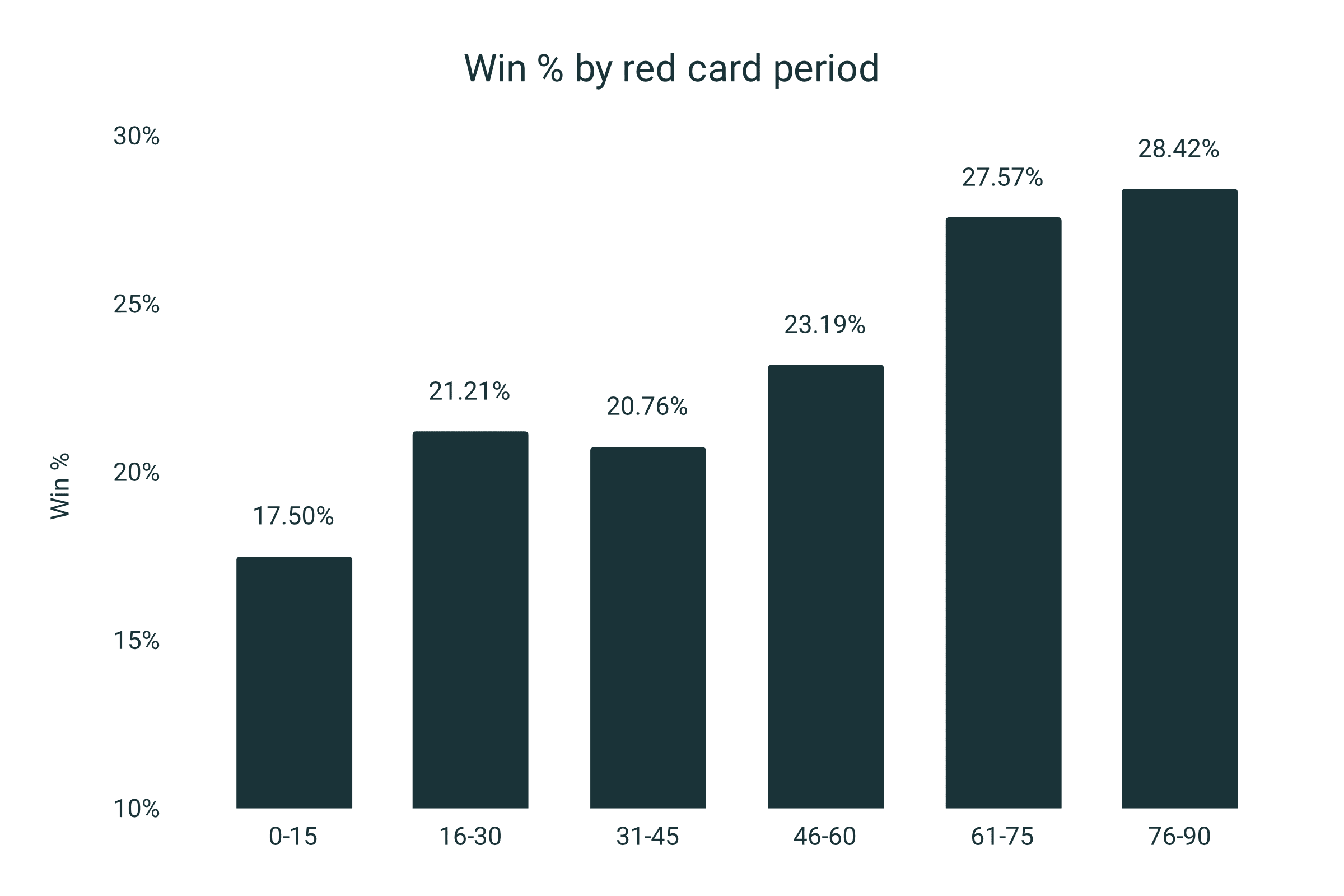
When a team receives a red card in the first 15 minutes of a game, they go onto win 17.50% of the team. When a team receives a red card in the final 15 minutes of a game, they go on to win in 28.42% of games.
This means a team is 62.4% more likely to win if they get a red card in the last 15 minutes of games than if they receive a red card in the first 15 minutes of a game.

Naturally, this goes hand in hand with the loss percentage. A team receiving a red card in the first 15 minutes of the game will lose 64.16% of the time. Whereas, a team receiving a red card in the final 15 minutes of a game will lose 50.28% of the time.
This means a team is 21.63% more likely to lose if they get a red card in the first 15 minutes of a game than if they get a red card in the last 15 minutes of a game.
Keeping 11 players on the pitch for as long as possible has a significant impact on the outcome of a American football match.
How often does a team win with 10 men?

Taking timing out of the equation, when a team receives a red card they are more likely to lose than they are to either draw or win.
Of the games with 1 red card, the team with 10 men lost 55.21% of the time and drew or lost a combined 44.79% of the time (winning 23.61% and drawing 21.18%.)
What happens after a red card?
Goals
In games with one red card, 40.72% of the time the team with 10 men conceded a goal after the red card.
On it’s own that might not be particularly surprising, but in well more than half (56.45%) of these games, a goal came within 15 minutes and within 80.19% of these games they conceded within 30 minutes.
Substitutions
After a red card, 90.57% of games had a substitution for the team with 10 men. 55.97% of those games saw a substitution within 5 minutes and 80.79% of those games saw a substitution within 15 minutes of the red card.
Conclusion
After studying the data, it's clear that away teams are at a severe disadvantage when it comes to red cards. Not only are they more likely to receive a red card, but once they get that red card, away teams are far more likely to lose the game than a home team would be. If you want to win a game away from home in any of Europe's top 5 leagues it is essential to maintain your discipline.
As simple as it sounds, the second most important thing to do is not get sent off early in the match. The early a team goes down to 10 men, the more likely they are to lose. It's as simple as that.
Show bad cleats the red card!
Bad cleats can cause havoc. If your studs are too short you will find yourself slipping all over the place - especially on grass. However, if your studs are too long (e.g. firm ground cleats on artificial grass), you can end up doing yourself some serious ankle, knee or back damage.
Don't just settle for Nike boots or Adidas boots because you trust the brand. You need to do a little more research so that you are getting the boots that will do what you need them to do.

